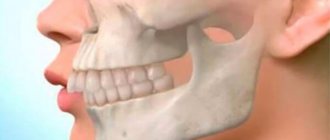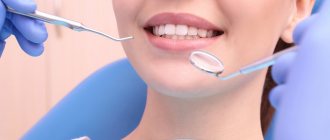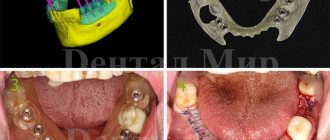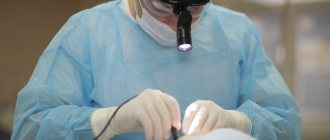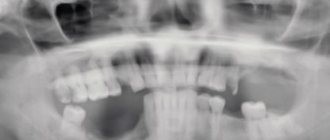Methods of treating the disease
Ameloblastoma is a benign odontogenic neoplasm, diagnosed in a significant number of patients. As a rule, the pathology develops between the ages of 20 and 50, occurring equally often in men and women. In some cases, the disease is detected in childhood and adolescence, accounting for about 6% of all benign jaw tumors. In approximately 80-83% of patients, the neoplasm affects the lower jaw, most often localizing in the area of its angle, much less often developing in the bone of the upper jaw. According to statistical studies, in most cases, ameloblastoma is detected in the initial stages of development, within about six months from the moment of occurrence. Often this pathology is detected by chance, during x-rays performed due to another dental disease. Some patients turn to the dentist with this problem when the disease has lasted for more than a year and the tumor has managed to affect a large area of the jaw. Recurrence of ameloblastoma is diagnosed quite often, in some cases developing years after surgical treatment. and when the pathological process is neglected, its course is unfavorable and there is no adequate therapy, there is a possibility of malignant degeneration (malignancy) of the tumor. Conducting in-depth studies of the disease allowed specialists to put forward several hypotheses related to the causes of its occurrence. It is assumed that the stimulating factors are disturbances in tooth formation and injuries of various types, but to date the reasons for the development of the disease have not been fully elucidated. Ameloblastoma develops very slowly, without causing discomfort to the patient for a long time. As the disease progresses, jaw deformation appears: facial asymmetry and swelling in the affected area become noticeable. It is typical that the degree of asymmetry varies from barely noticeable to pronounced. The symptoms of ameloblastoma of the upper jaw, which is much less common, visually appear even weaker, which is explained by the spread of the tumor process into the maxillary sinus. The occurrence of pain indicates the involvement of bone tissue in the pathological process, and patients often mistake this pain for dental pain. From this moment, displacement and loosening of the teeth begin to develop, and the thinning of the jaw bone with further progression of the disease manifests itself in a characteristic crunching sound. The development of maxillary ameloblastoma poses an even greater threat, since the tumor is likely to spread into the nasal cavity and orbit. At advanced stages of the pathology, the patient complains of intense pain, fistulas develop in the oral cavity, from which purulent exudate is released. Treatment of ameloblastoma involves surgical removal of the affected area of the jaw within the boundaries of unchanged tissue. The extent of the operation is influenced by the size, location and stage of development of the tumor. Since ameloblastoma in most cases is diagnosed at an early stage, the neoplasm does not have time to reach significant sizes. Such patients do not require resection or partial removal of the jaw; surgical intervention is not accompanied by disruption of the continuity of the jaw bone and the formation of cosmetic defects, and is often performed with preservation of functions. After removal of the tumor, in order to prevent recurrence, the resulting cavity is treated with a high concentration phenol solution, as a result of which the pathologically altered epithelial cells become necrotic. If a large ameloblastoma is detected, resection of the jawbone or partial removal of the jaw is indicated. If a focus of purulent inflammation develops, in parallel with the removal of the tumor, its surgical removal is carried out. Before the procedure, which is performed under general anesthesia or local anesthesia, the oral cavity must be sanitized. During the postoperative recovery period, the patient is prescribed courses of antibiotics and symptomatic drug therapy. Coarse and hard foods and dishes that require thorough chewing are excluded from the patient’s diet. After each meal, the patient must rinse the cavity formed after the operation. In the case of removal of a significant portion of the jaw bone to restore lost functions and eliminate cosmetic defects, bone grafting surgery using individually made orthopedic structures is indicated.
Microsurgical operation. Ameloblastoma of the jaw.
Key words: jaw defect, dental implantation, restoration of chewing function in patients with jaw defects, computer gnathography.
Ameloblastoma or adamantinoma is a benign tumor belonging to tumors of the maxillofacial localization. Typically, ameloblastoma spreads to the lower jaw. Such a tumor has a slow growth, occurs without any special symptoms, but gradually leads to deformation of a person’s lower jaw. Very often, patients complain of impaired chewing function, loosening and displacement of the dentition. On examination, patients experience facial asymmetry, swelling of the lower jaw, its thickening or protrusion.
The staff of the scientific and clinical department of maxillofacial surgery of the Federal State Budgetary Institution Scientific Center of Otorhinolaryngology of the Federal Medical and Biological Agency of Russia has accumulated a wealth of experience in the diagnosis and treatment of patients with defects of the lower jaw. All surgeons of the department have scientific titles, have completed internships in the world's leading maxillofacial surgery clinics, and are proficient not only in the most modern domestic and foreign techniques, but also actively use their own developments.
In our Center, an important link in the accurate diagnosis of patients with ameloblastoma is the use of biometric examination methods (CT, computed tomography, electromyography). Treatment of patients with defects of the lower jaw is aimed not only at restoring chewing and swallowing functions and correct bite, but also at restoring facial aesthetics.
ameloblastoma of the lower jaw, specialists from the scientific and clinical department of maxillofacial surgery use the technique of using flaps with axial circulation and the technique of preoperative 3-D computer modeling. Based on the modeling results, special templates are made that accurately determine the size of the bone component of the flaps. Our experts believe that such a modern approach is necessary and is due to both functional and socio-aesthetic rehabilitation of patients who have lost their jaw. Successful operations after bone grafting with autografts demonstrate the correctness of an integrated approach to the treatment of patients with defects of the lower jaw, clearly demonstrate the ability of the attached muscles to contract and maintain muscle tone, which creates good conditions for further prosthetics with implants and creating optimal occlusion.
Examples of clinical observation
A patient diagnosed with large ameloblastoma of the lower jaw. Ameloblastoma of the lower jaw was removed with simultaneous surgical reconstruction
BEFORE TREATMENT |
INTRAORAL PHOTOS |
MSCT - 3D SCANS |
3D modeling |
STL templates |
Photo 20 days after surgery |
PATIENT WITH DIAGNOSIS: defect of the lower jaw on the left, facial asymmetry, impaired chewing function, condition after subtotal resection for sarcoma
CT scans of the patient before surgery |
CT scans after surgery: there is a tendency towards an open bite, despite the precise position of the graft in the temporal fossa. |
Patient’s bite at the stage of orthodontic treatment (Bite correction) |
Patient's bite after removing braces |
AFTER dental implantation, formers are installed and temporary prosthetics supported on implants are performed |
CT scans of the patient with muscle visualization: attachment of the masticatory muscles to the bone component of the previously transplanted graft on the left is noted |
Formation of the coronoid process |
Electromyography at rest before relaxation. Significant hypertonicity of the anterior fibers of the temporal muscles. |
EMG after electrical neurostimulation. The tone of all muscle groups is balanced and the indicators are significantly lower. When teeth are closed, the tone of the temporal and masticatory muscles increases. |
The compression test revealed good involvement of muscle fibers of the temporalis muscles in function and decreased involvement of muscle fibers of the masseter muscles, especially on the left. |
EMG compression after electrical neurostimulation. Increased involvement of muscle fibers in function by almost 2 times. |
Computer gnathography. Slight limitation of mouth opening. Deviation of the lower jaw to the left when opening the mouth. |
PATIENT WITH DIAGNOSIS: ameloblastoma of the mandible of the mental region
| CT scan | Simulation of resection | Position of the fibular autograft |
Photographs in the postoperative period show the patient’s unchanged postoperative appearance, fixed prosthetics, and a CT scan 2 months after surgery. |
At OPTG, dental implants used for fixed prosthetics are determined |
Attachment of the digastric and mylohyoid muscles to the fibular graft. |
Diagnostics on the K7 device |
Patient's myography results |
PATIENT K., 26 years old, was admitted to the clinic with a diagnosis of ameloblastoma of the lower jaw on the right.
The appearance of the patient upon admission, OPG, CT images, 3D modeling of the operation, stereolithographic templates. |
Appearance of the patient after surgery. |
OPTG and CT gram demonstrate the anatomy of the reconstructed alveolar process. |
The OPTG shows installed dental implants 6*16 mm in the projection of 4.4, 4.5, 4.6, 4.7 teeth. |
CT scans show attachment of the masticatory muscles to the iliac autograft. |
How is the disease diagnosed?
Examination of a patient, diagnosis and development of a treatment regimen takes about three days in Israeli clinics.
On the first day of stay at the medical center, the patient undergoes a consultation with a leading dentist.
At the appointment, the doctor gets acquainted with the medical history, clarifies the symptoms that are bothering the patient, and conducts an examination of the oral cavity. At the final stage of the consultation, the specialist prescribes the required examinations. The next day, the types of diagnostic procedures indicated in the list of appointments are performed:
- X-ray examination (general X-ray of the upper and lower jaw,
- lateral projection, axial radiography);
— computed tomography (CT);
— puncture of the tumor followed by laboratory cytological analysis of the obtained material (the most informative method of diagnosis).
The research results are reviewed by a medical commission, which includes a dentist and highly specialized specialists. Doctors collectively make a diagnosis and build a treatment plan.
Advantages of treatment in Israel
- High level of qualifications and extensive experience of doctors.
- Availability of modern diagnostic and treatment equipment.
- Quickly and accurately diagnose.
- Application of modern methods of therapy.
- Reasonable prices.
The success of therapy and the least number of complications directly depend on the implementation of a treatment course at an early stage of the disease. Don’t waste time, contact your chosen Israeli clinic and start treatment as soon as possible.
- 5
- 4
- 3
- 2
- 1
(0 votes, average: 5 out of 5)
Symptoms
The early stages of the development of the disease practically go unnoticed by the patient. As the disease progresses, the following symptoms will indicate the presence of a tumor:
- changes in facial symmetry – they can be pronounced and subtle
- the appearance of swelling on the face at the site of tumor development
- the appearance of pain in the area where the tumor is located
- displacement or loosening of teeth
- minor jaw deformation
- the appearance of a characteristic parchment crunch of the jaw
- deformation of the alveolar process

